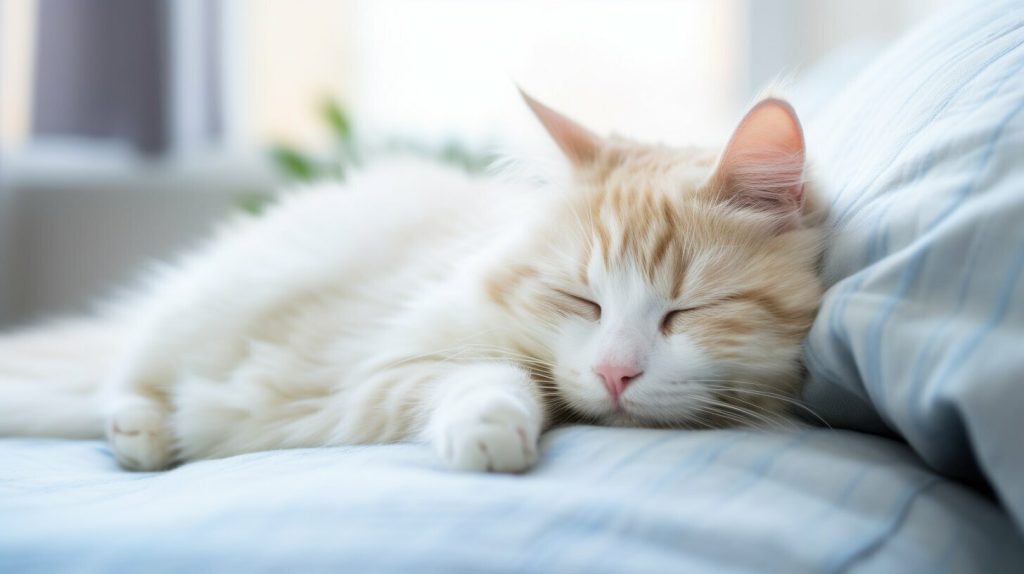Last Updated on September 22, 2023
As a cat owner, you might be curious about the behavior changes you can expect in your female cat after she gets spayed. Spaying is a routine surgical procedure that has many health and behavioral benefits for cats. However, it’s common for cats to display certain changes in behavior after the procedure due to the alteration of their hormones. Understanding these changes can help you provide the right care for your cat during the recovery and adjustment period.
To get started, let’s take a closer look at how female cats behave after being spayed and the behavior changes that come along with it. Read on to discover what you can expect from your furry friend after the surgical procedure and how to handle the changes in behavior.
- 1 Understanding the Spaying Procedure and Recovery
- 2 Immediate Changes in Behavior
- 3 Adjusting Period and Behavioral Patterns
- 4 Tips for Supporting Your Cat’s Behavioral Changes
- 5 Monitoring Your Cat’s Well-being
-
6
Frequently Asked Questions
- 6.1 Will my cat’s personality change after being spayed?
- 6.2 Will my cat become less active after being spayed?
- 6.3 Will spaying my cat stop her from spraying?
- 6.4 How long should I expect my cat’s behavior to change after being spayed?
- 6.5 When can I expect my cat to fully recover from the spaying procedure?
Understanding the Spaying Procedure and Recovery
Spaying is a common surgical procedure that involves removing a female cat’s reproductive organs. This procedure has several benefits, including reducing the risk of developing certain diseases and preventing unwanted pregnancy. However, it can also cause changes in your cat’s behavior. It’s crucial to understand the spaying procedure and the associated recovery period so that you can provide the best care for your feline friend.
What Happens During the Spaying Procedure?
The spaying procedure, also known as an ovariohysterectomy, involves removing a female cat’s ovaries and uterus. The surgery is typically performed under general anesthesia, and your cat will need to stay at the veterinary clinic for a few hours or overnight for observation.
| Before the procedure | After the procedure |
|---|---|
| • Your cat will need to fast for a specific amount of time before the surgery • The vet may conduct a blood test to ensure your cat is healthy enough for the procedure • Your cat will receive anesthesia • The vet will make an incision on your cat’s abdomen to remove the ovaries and uterus • The incision could be closed with stitches, staples, or glue, depending on the vet’s preference |
• Your cat may be groggy or disoriented due to the anesthesia • Your cat may be given pain medication • Your cat may need to wear a cone or e-collar to prevent her from licking or biting the incision site • Your cat may need to stay at the vet clinic for a few hours or overnight for observation • You’ll need to monitor your cat’s behavior and follow the vet’s post-surgery instructions closely |
What Changes Can You Expect After Spaying?
After the spaying procedure, your cat may experience behavioral changes. These changes can vary depending on your cat’s age, personality, and overall health, but some common changes include:
- Reduced appetite
- Decreased energy levels
- Increased affection or neediness
- Less “talkative” or vocal
- Less territorial or aggressive towards other cats
It’s normal for your cat to experience these changes, but it’s crucial to monitor her closely. If you notice anything concerning or unusual, contact your vet for advice.
What Is the Recovery Process Like?
The recovery process after spaying can take anywhere from a few days to a few weeks. During this time, it’s essential to provide your cat with a comfortable and safe environment. You can help your cat recover by:
- Providing a quiet space for your cat to rest and recover
- Maintaining a consistent routine
- Offering small, frequent meals to encourage your cat to eat
- Encouraging gentle play and exercise once your vet gives the green light
- Monitoring the incision site for redness, swelling, or discharge
By following these tips and closely monitoring your cat’s behavior and recovery, you can help ensure a smooth and successful spaying procedure.
Immediate Changes in Behavior
After being spayed, your female cat’s behavior may change in a number of ways. One of the most noticeable changes is a decrease in energy levels.
Spaying eliminates the hormonal drive to mate, which can result in a less active cat. It’s important to provide your cat with plenty of opportunities for exercise, but also to be mindful of her new limitations. Avoid pushing her too hard and allow her to rest when she needs to.
Another change you may notice is a decrease in appetite. This is typically a temporary change and should resolve itself within a few days. However, it’s important to monitor your cat’s food intake and make sure she’s getting enough to eat. If she continues to refuse food after a few days, consult with your vet.
It’s also not uncommon for your cat to be more affectionate or clingy after being spayed. This may be due to a decrease in territorial behavior and a desire to seek comfort from her human family. While it’s certainly important to show love and support during this time, it’s also important to establish boundaries. Encourage your cat to explore her surroundings at her own pace, and avoid forcing affection if she seems uncomfortable.
Other changes you may notice include a decrease in vocalization and a general change in temperament. Some cats become more submissive or docile after being spayed, while others may become more irritable or aggressive. These changes are usually temporary and will resolve themselves in due time.
Remember to be patient with your cat during this transitional period. Allow her to adjust to her new hormone levels and behavior patterns, and provide plenty of love and support along the way.
Adjusting Period and Behavioral Patterns
After being spayed, female cats will go through an adjusting period as their hormones rebalance. During this time, you may notice changes in their behavior that can last for several months.
One of the main changes you may observe is a decrease in territorial marking. Female cats who have not been spayed may spray urine as a way to mark their territory, but this behavior usually decreases after surgery.
| Behavior | Description |
|---|---|
| Vocalization | Some cats may become more vocal after being spayed, while others may become quieter. If your cat starts meowing excessively, it could be a sign of anxiety or discomfort and should be addressed with your veterinarian. |
| Temperament | Your cat’s temperament may also change after being spayed. Some cats become more affectionate, while others may become more aloof. Be patient with your cat during this adjusting period and offer plenty of positive reinforcement. |
It’s essential to note that every cat is unique, and their behavior changes may vary. Some cats may not show any noticeable changes, while others may exhibit more. Monitor your cat’s behavior and contact your veterinarian if there are any concerns or significant changes in their behavior.
Providing a comfortable and stable environment for your cat during this adjusting period is crucial. Keep their routine as consistent as possible, and avoid introducing any major changes, such as a new pet or moving to a new home. Offering plenty of affection and positive reinforcement is also essential in helping your cat feel secure and calm.
Tips for Supporting Your Cat’s Behavioral Changes
Spaying can cause significant changes in your female cat’s behavior. These changes may be temporary or long-lasting, depending on your cat’s personality and how well you manage the transition. Here are some tips to help you support your cat’s behavioral changes:
- Provide a calm and secure environment: After surgery, your cat will need a peaceful place to rest and recover. Create a cozy spot for her with a soft bed, plenty of fresh water, and a litter box nearby.
- Implement positive reinforcement techniques: Encourage your cat to engage in good behavior by rewarding her with treats, praise, and playtime. This will motivate her to behave well and make the transition easier.
- Introduce new routines gradually: Changes in behavior can be stressful for cats, so it’s important to introduce new routines slowly. Give your cat time to adjust to any new schedules for feeding, playtime, and sleeping.
- Offer plenty of interactive toys: Toys can help distract your cat from any discomfort or boredom she may experience during recovery. Choose toys that encourage exercise and playtime to keep her mind and body active.
- Be patient and understanding: Behavioral changes may take time to resolve, and your cat may exhibit different behaviors during her recovery period. Be patient and understanding, and offer plenty of love and support to help her feel safe and secure.
Remember, every cat is different, and there is no one-size-fits-all solution for managing behavioral changes after spaying. Keep a close eye on your cat’s behavior, and seek veterinary attention if you notice any signs of discomfort or distress. With proper care and support, your furry friend will adjust to her new hormonal balance and enjoy a happy, healthy life.
Monitoring Your Cat’s Well-being
While spaying is a routine surgery, it is still important to monitor your cat’s well-being during their recovery. There are a few signs to look out for that may indicate complications or discomfort:
| Signs of potential complications: | – Excessive pain – Excessive bleeding – Changes in appetite – Lethargy or weakness – Abnormal behavior – Swelling or discharge at the incision site |
|---|
It is important to be vigilant during this time and to seek veterinary attention if you notice any of these signs. Your vet may be able to recommend additional measures to ensure a smooth recovery for your cat.
It is also important to follow any post-operative instructions given by your vet, such as limiting your cat’s activity level and monitoring their incision site. By providing proper care and attention during this time, you can help ensure the best possible outcome for your cat’s post-spay recovery.
Frequently Asked Questions
As a cat owner, it’s natural to have questions about how your female feline will behave after being spayed. Here are some commonly asked questions and their answers to clarify any uncertainties you may have.
Will my cat’s personality change after being spayed?
Personality changes are not typical after spaying a cat. However, some cats may become less territorial or vocal due to the hormonal changes that occur after surgery.
Will my cat become less active after being spayed?
It’s common for a cat to be less active for a few days or weeks after being spayed. However, this is usually due to the recovery process and not the spaying itself. With proper care and attention, your cat should return to her usual activity level within a few weeks.
Will spaying my cat stop her from spraying?
Yes, spaying your female cat will drastically reduce the likelihood of her spraying. Spaying removes the reproductive organs responsible for producing the hormones that influence spraying behavior. However, it’s important to note that some cats may continue to spray even after being spayed.
How long should I expect my cat’s behavior to change after being spayed?
Your cat’s behavior may change for several weeks after being spayed as her body adjusts to the hormonal changes. However, most cats return to their usual behavior within a few months. If your cat’s behavior continues to significantly deviate from her usual patterns, consult with your veterinarian.
When can I expect my cat to fully recover from the spaying procedure?
It typically takes a cat 7-10 days to recover from spaying. During this time, you should restrict her activity level and monitor her closely for any signs of discomfort or complications. After the initial recovery period, your cat may exhibit subtle behavior changes for several weeks as her hormones continue to rebalance.














